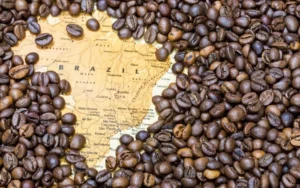Brazil’s coffee trail offers a fascinating journey through the heritage and production of one of the world’s most beloved beverages.
This article guides coffee enthusiasts through the origins of coffee in Brazil, presenting an overview of the country’s current coffee scene.
Additionally, it outlines various coffee routes travelers can explore, from Minas Gerais to Paraná and São Paulo, showcasing the rich history and diverse coffee culture of Brazil.
Coffee has captivated global audiences, regardless of the variety or brewing method.
For those interested in immersive tourism, Brazil’s coffee routes provide a deep dive into the history of this staple commodity.

However, as a leading coffee producer, Brazil offers several routes that highlight the country’s significant role in the coffee industry.
A Glimpse into History
Coffee cultivation is deeply entwined with Brazil’s history, playing a crucial role in the economy during the 19th and 20th centuries.
Introduced in 1727 by Sergeant Major Francisco de Mello Palheta, coffee quickly became Brazil’s most significant export by 1837.
Initially focused on domestic consumption, the industry’s capital came from farmers and traders, who prospered with the arrival of the royal family in 1808.
The introduction of coffee to the plantation system, characterized by monoculture, slave labor, and large estates for export, facilitated its spread across the country.
Current State of Coffee Production in Brazil
Brazil has maintained its status as the world’s largest coffee producer for over 150 years, contributing to 80% of the global supply at its peak.
Today, Brazil accounts for 20% of the world’s coffee, with a yearly consumption of five kilograms per person.
The main coffee-producing states are Minas Gerais, São Paulo, and Paraná, with a significant portion of the production being exported.
Navigating Brazil’s Coffee Routes
Brazil’s coffee routes offer tours across regions known for coffee production, such as Minas Gerais, Paraná, and São Paulo.
These routes allow visitors to explore historical buildings, taste different coffee beans, and immerse themselves in the coffee-making process.
Paraná Coffee Route:
This route spans nine cities and offers 30 attractions within a 200-kilometer radius.
Visitors can explore lodgings, farms, museums, and restaurants showcasing the region’s rich coffee heritage.
Minas Gerais Coffee Route:
Explore stunning landscapes and top-tier coffee production along the route through Serra da Mantiqueira, Carmo de Minas, and São Lourenço.
Green Coffee Route in Ceará:
This route features a mix of beach and mountain landscapes, centered around the Baturité region, known for its historical, architectural, and natural beauty.
São Paulo Coffee Route:

